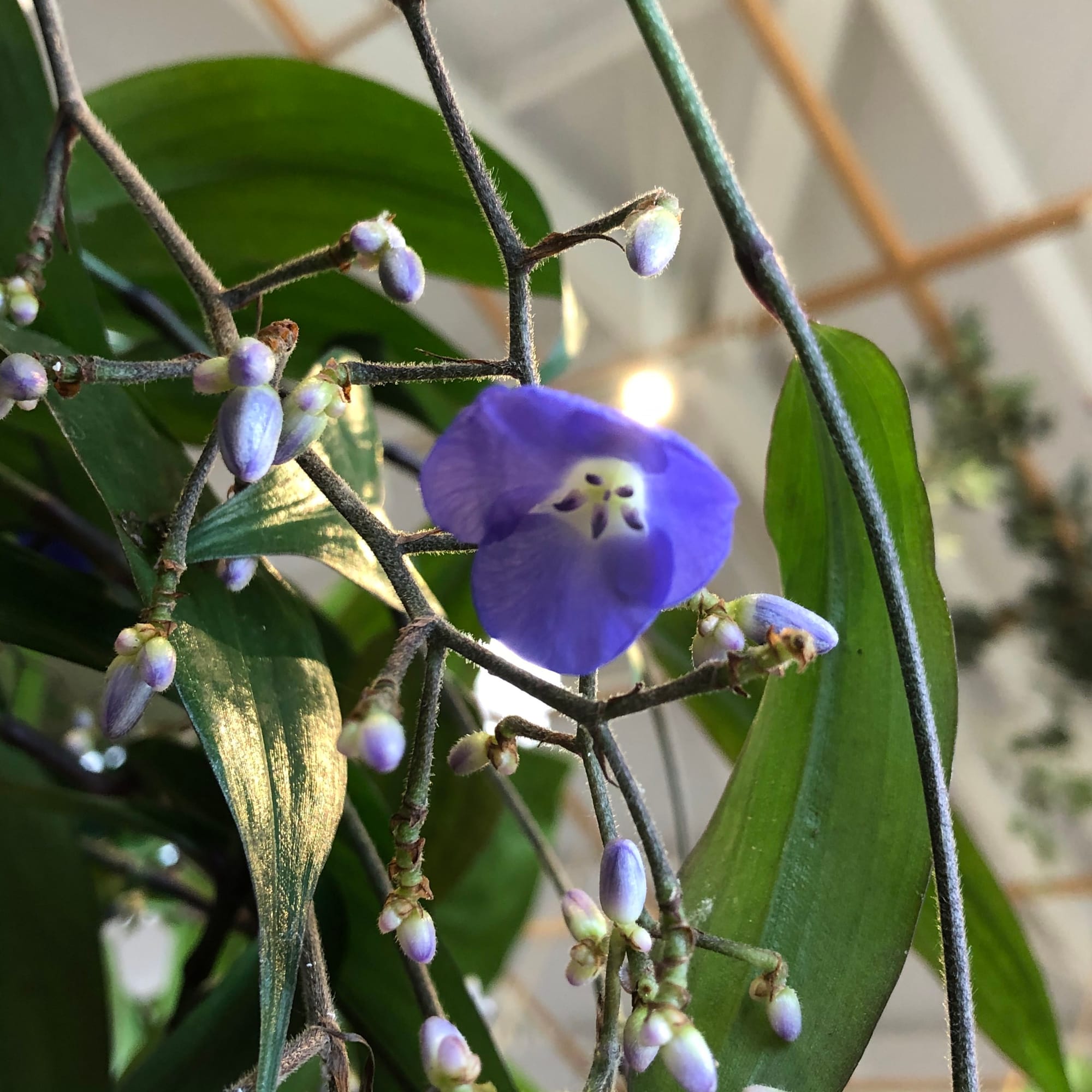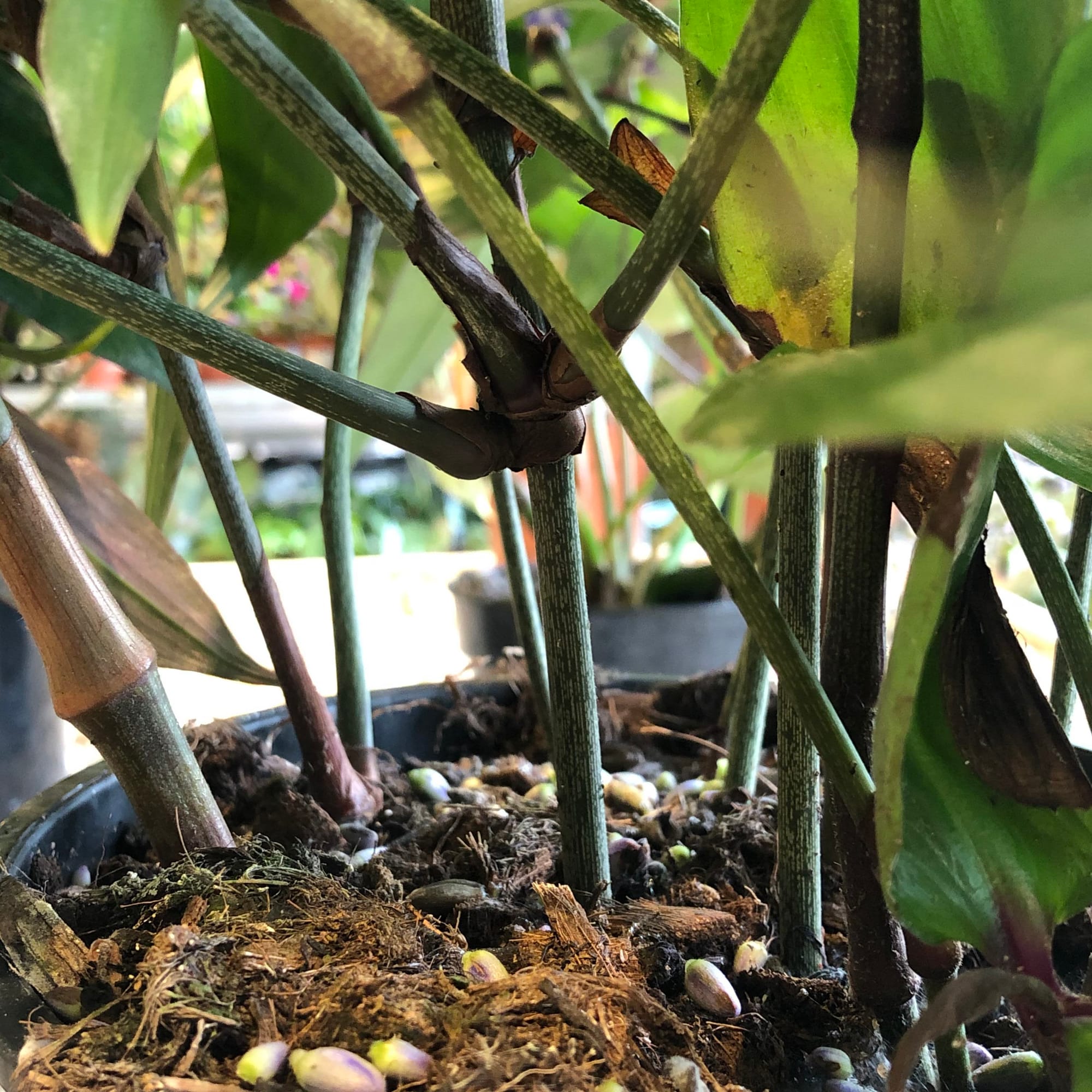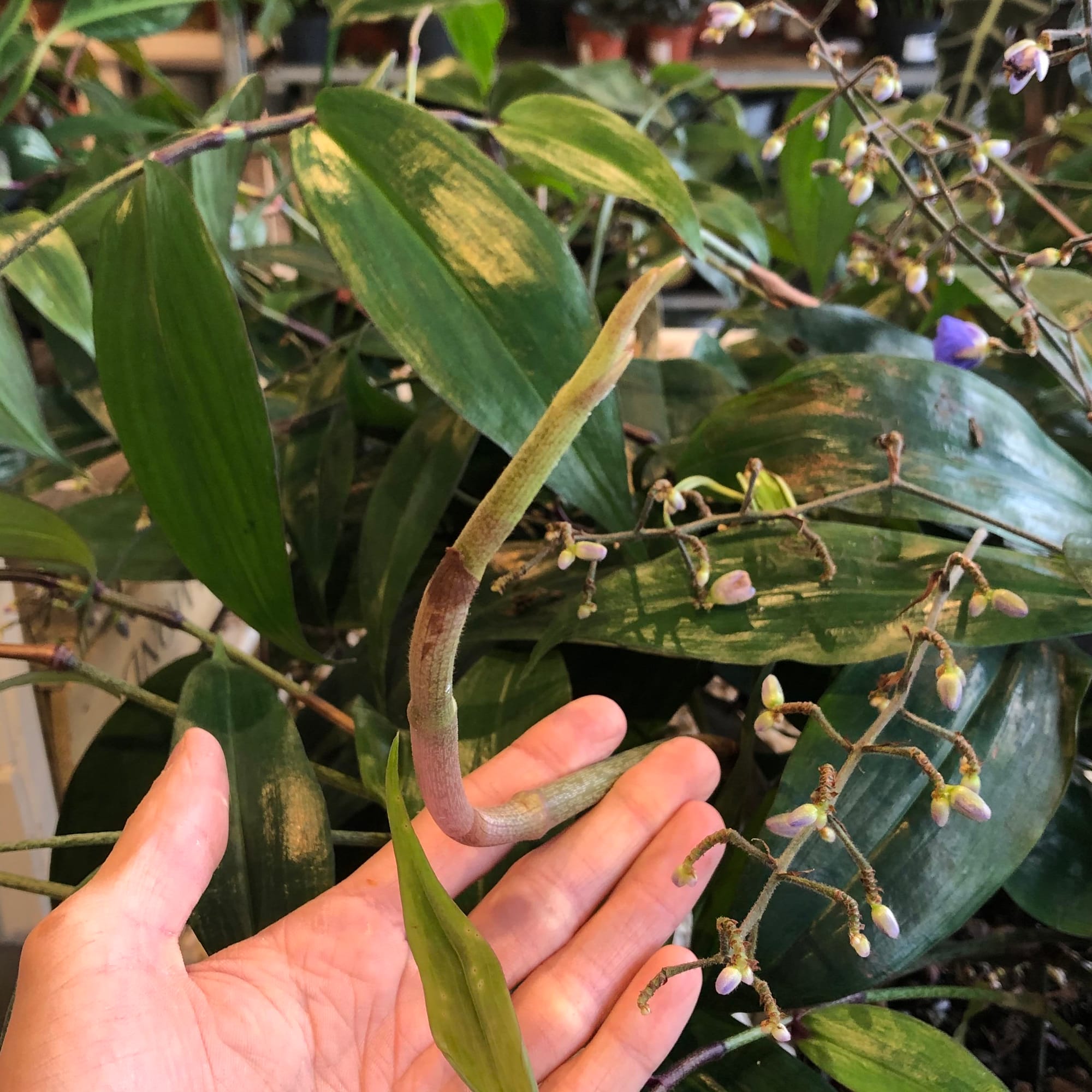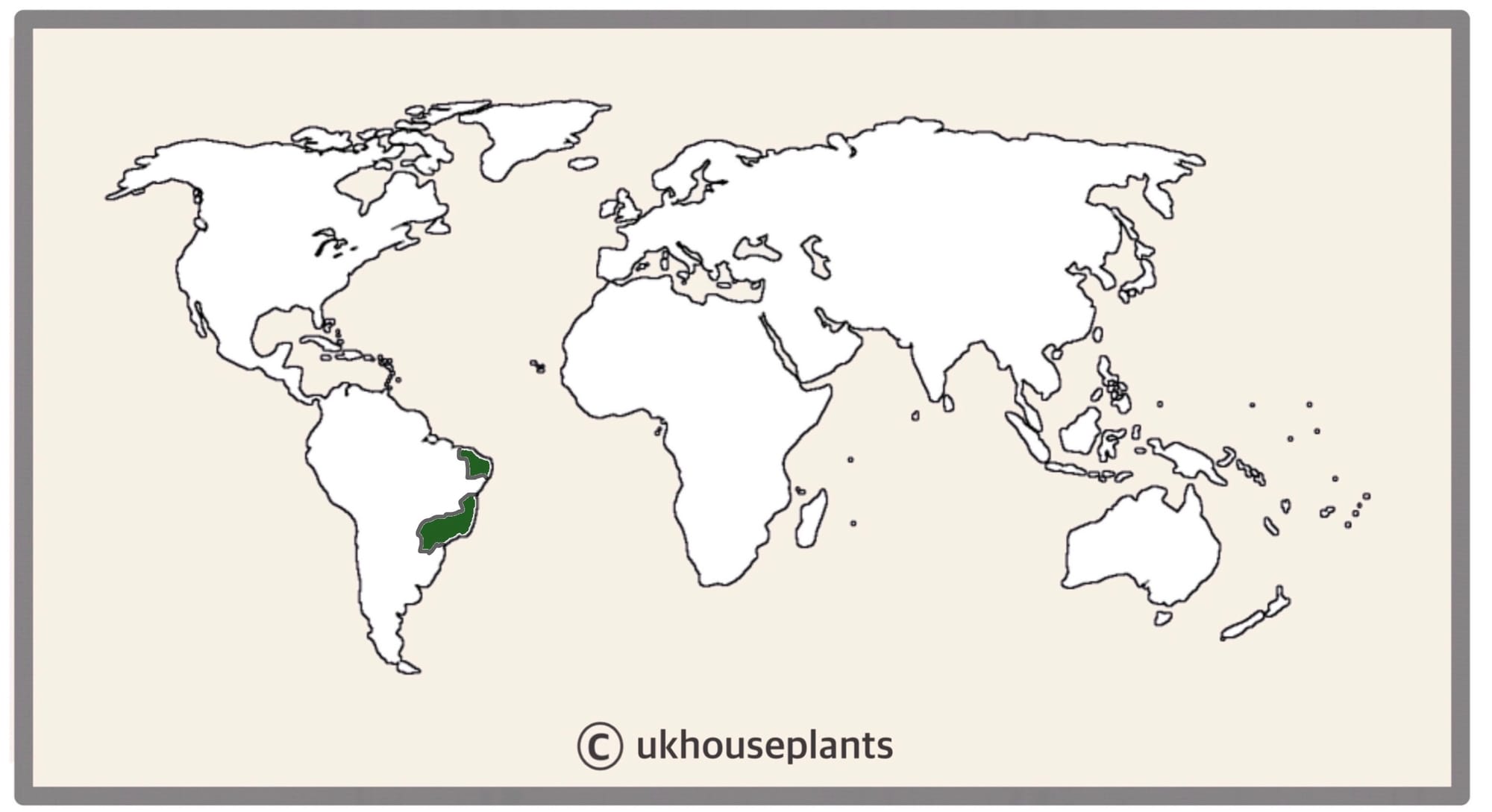
Dichorisandra thyrsiflora
Contents
- Top Tips
- Location, Water, Humidity & Fertilisation
- Common Issues
- Origins, Temperature, Propagation, Repotting & Toxicity
Need the answer to a specific plant query? Book a 1-to-1 video call with Joe Bagley, the website's friendly author, to overcome and address your niggling problem! Available on iMessage, WhatsApp, Facebook Messenger & more.
Top Tips & Info
- Care Difficulty - Easy to Moderate
- Provide a bright location with an absence of direct sunlight or deep shade. Too much sunlight will increase the risk of sun-scorch, whereas the latter will result in a lack of new growth. A location within two metres of a light source is perfect for good quality growth.
- Keep the soil evenly moist at all times, allowing the top third to dry between hydrations.
- Fertilise using a 'Houseplant' labelled feed every four waters in the spring and summer, reducing this to every six in the colder months.
- Repot every three years with a 'Houseplant' labelled potting mix; be sure to respect the roots as transplant shock is a big issue that could cause wilting, sudden leaf loss or even death.
- Keep an eye out for Mealybugs that'll attack the cubbyholes of the plant, including its leaves, stems and flowers.
Location & Light - 🔸🔸
Perfecting the amount of light a Blue Ginger receives is crucial for a long-lasting specimen. During the spring and summer, be sure to provide a brightly lit spot away from any direct light. Excessive exposure during this time will negatively affect the plant in the likes of sun-scorch and dehydration. Once the autumn kicks in, be sure to include an hour or two of direct light per day to get it through the dormancy period, lasting until the following spring.
Water - 🔸🔸
Blue Ginger craves moist soil - once the top third of the soil dries out, it's time for another water. During the autumn and winter, be sure to reduce the watering slightly further, so that around half of the compost dries between waters. Under-watering symptoms include crispy/curling leaves, a grey, washed-out appearance, yellowing leaves and a lack of new growth. These issues are commonly down to either too much heat/light forgetfulness. Dehydration is the number one issue among growers, so always keep an eye out for drying soil. Over-watering symptoms, on the other hand, include yellowing lower leaves, little to no growth and a rotting stem or leaves. Never allow Blue Ginger to endure long periods of soggy soil or a dark location as both will significantly increase the chance of over-watering and death.
Humidity - 🔸🔸
Average humidity found in the home is more than enough to occupy Blue Ginger. If the leaf-tips begin to brown over, it could be a sign of too low humidity; either finely mist the foliage weekly or introduce a humidity tray to keep life happy.
Fertilisation - 🔸🔸🔸
Fertilise every four waters during the growing period before reducing this to every six in the autumn & winter. Although an 'All-Purpose' fertiliser will still do the job, we'd recommend using a specific 'Houseplant' labelled fertiliser as it'll support the vital thirteen nutrients that this species will need to grow.
 You can easily take stem cuttings throughout the year using at least one node, pictured in the centre of the photo. Scroll down to 'Propagation' for more information!
You can easily take stem cuttings throughout the year using at least one node, pictured in the centre of the photo. Scroll down to 'Propagation' for more information!
Common Issues with Blue Ginger
Too much sunlight will lead to sun scorch, with typical signs including browning or crispy leaves, dry leaf-edges, sunken leaves or stunted growth. Although too little light will cause over-watering issues, too much sunlight will be a detriment, too. If yours has fallen short of this, reduce the amount of the sun considerably and always be mindful of environmental shock (when two locations offer too different growing conditions). Remove some of the affected leaves and increase waters slightly.
Never situate it within four metres of an operating heat source, for instance, a heater or fireplace. Due to the heightened temperature, the plant will soak up far more moisture than those situated in cooler locations, increasing the chance of droughts and browning leaf-edges.
Root rot is another common issue. Typical symptoms include rapidly yellowing leaves, stunted growth and stem collapse. Those situated in darker locations and/or too-soggy soil are most likely to be hit with this issue. Take the plant out of the pot and inspect its root systems - if they sport a yellow appearance, you're okay, but if they're brown and mushy, action must be taken immediately. More information about addressing root rot can be found on this link.
 Blue Ginger can become very leggy over time, so it's important to prune the leading growths every two years to promote a bushy appearance. These cuttings can also be used for propagation!
Blue Ginger can become very leggy over time, so it's important to prune the leading growths every two years to promote a bushy appearance. These cuttings can also be used for propagation!
Origins
Dichrosandra was first described by Johann Christian Mikan in the 1820s, along with the type species, D. thyrsifolia. He used the Latin words di, chōris & andra to describe the doubled anthers of the flowers put out in the summer and autumn. The first specimen in the U.K. to be documented was in 1822 by Sir William MacArthur's catalogue, Hortus Camdenensis. The Latin specific epithet, thyrsiflora, means "with flower clusters resembling Thyme". The species natural distributions across localised areas of eastern Brazil, including Fortaleza and São Paulo.
 The Distribution of Dichrosandra thyrsiflora.
The Distribution of Dichrosandra thyrsiflora.
Temperature
12° - 30°C (54° - 86°F)
H1b - can be grown outdoors in the summer whilst the nighttime temperatures are above 12°C. If you decide to bring this houseplant outdoors, do not allow it to endure more than an hour of direct sunlight a day as this will burn the leaves. Regularly keep an eye out for Aphids, especially when re-introducing it back into the home.
Spread
Up to 1.5m in vine length when given enough space - the ultimate height will take between 3 - 6 years to achieve. The growth rate is rapid - some cases can see specimens grow up to 30cm per year!
Pruning & Maintenance
Remove yellow or dying leaves, and plant debris to encourage better-growing conditions. While pruning, always use clean utensils or shears to reduce the chance of bacterial and fungal diseases. Never cut through yellowed tissue as this may cause further damage in the likes of diseases or bacterial infections. Remember to make clean incisions as too-damaged wounds may shock the plant, causing weakened growth and a decline in health.
Propagation
Via Seed or Vine Cuttings.
Vine Cuttings
- Choose the healthiest, most established vines from the leading growths. This propagation method can be taken from spring to summer, using between three to six leaves, with the vine being at least 10cm (4 inches) in length. Remove the bottom half of the leaves to aid the production of roots.
- Cut directly below a node (leaf), using a clean knife to reduce bacteria count. Have a look at the image above if you're stuck.
- Place the bottom half of the cutting into water to root - this process will be quick and should only take a few weeks. Once small roots surpass 5cm in length (2 inch+), it's time to prepare the soil and pot.
- Use a 7cm (3 inch) pot with good drainage holes - plastic or terracotta are both acceptable in this instance.
- Set the cutting's rooted half into a well-draining compost, for example, 'Houseplant' compost, keeping the foliage above the soil line.
- Provide a bright, indirect setting with relatively moist soil. After a month of being placed in soil, treat it as an ordinary houseplant with the care requirements mentioned above.
Flowers
Blue Ginger will readily flower in the summer and autumn if its previous dormancy period has been served well. Small, purple Thyme-like flowers will develop at the vines' terminals that can last up to several weeks. The quality of its blooms largely relies on the quality of the dormancy period served in the previous winter.
To replicate its dormancy period over the course of autumn and winter:
- Reduce temperatures down to around 15°C (59°F) from late autumn until early spring, with little hydrations or fertilisation.
- Allow all of the soil to dry out for at a fortnight in between irrigations thoroughly, and never apply cold water as this may damage the roots.
- Provide a few hours of off-peak direct sunlight with one fertilisation throughout this period, until the first bud develops at the end of spring.
Repotting
Repot every three years in the spring, using a 'Houseplant' labelled compost and the next sized pot with adequate drainage. Blue Ginger are far better being potbound for several years due to the heightened risk of root rot and repotting-issues (like transplant shock), so only repot if you feel it's wholly necessary - restricted root growth will also increase the chance of blooms, too.
Hydrate the plant 24hrs before tinkering with the roots to prevent the risk of transplant shock. For those situated in a darker location, introduce an extra amount of perlite and grit into the deeper portion of the pot to downplay over-watering risks. Click here for a detailed step-by-step guide on transplantation, or via this link to learn about repotting with root rot.
Book a 1-to-1 video call with Joe Bagley if you'd like a personal guide to repotting your houseplant. This will include recommending the right branded-compost and pot size, followed by a live video call whilst you transplant the specimen for step-by-step guidance and answer any further questions!
Pests & Diseases
Keep an eye out for spider mites, mealybugs, aphids, whitefly, root mealybugs, scale & thrips. Typical diseases associated with Blue Ginger are leaf-spot disease, botrytis, powdery mildew & root rot. Click here for more information about how to identify and address any of these issues.
Toxicity
Not known to be poisonous when consumed by pets and humans. If large quantities are eaten, it may result in vomiting, nausea and a loss of appetite.
Retail Locations
Online Stores.
Book a 1-to-1 Call with Joe Bagley
If you need further advice with your houseplants, book an advice call with ukhouseplants' friendly and expert writer today! This can be done via a video or audio call on most apps, including Facebook, FaceTime & Skype. A ten-minute call costs £5.99 (US$7), or £15.99 for thirty minutes. You can ask multiple questions, including queries on plants, pests, terrariums, repotting advice and anything in between. Please consider supporting this service to keep ukhouseplants thriving!